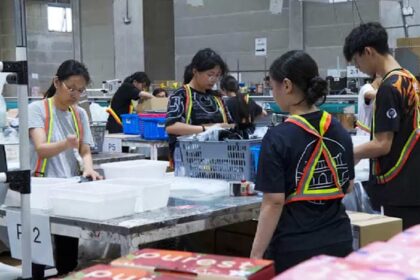Why solar is surging now
Across Myanmar, a quiet but sweeping shift is underway. After Thailand cut power flows across the western border in 2025 to target online scam operations, the impact rippled far beyond those criminal hubs. In towns like Myawaddy, hospitals, offices, and households scrambled to install solar panels. Local residents say three out of four people now rely on solar in some neighborhoods, while businesses stack multiple panels and small batteries to keep lights, refrigeration, and payments running.
This turn to rooftop solar is born of necessity. Myanmar’s electricity system has deteriorated since the 2021 military takeover and the spread of civil conflict. Blackouts have become routine, and maintenance has grown difficult under Western sanctions. The World Bank estimates that operating power capacity fell back to 2015 levels by 2024. Satellite readings of light intensity, a proxy used by the United Nations for economic activity and electricity access, have dropped on average by about 8 percent a year since the coup. As the grid falters, Chinese manufacturers have filled the gap with low-cost solar modules, while local installers have multiplied.
Behind the outages sit hard constraints. Domestic natural gas, the backbone of Myanmar’s thermal power, is declining. Liquefied natural gas imports were frozen for lack of foreign currency. Sanctions have made it harder to secure spare parts and technical support for aging plants and substations. The authorities have said generation capacity has fallen by nearly half from pre-2021 levels, while some official statistics still show limited change in output since 2018. What most people see and feel is not a spreadsheet, but rolling outages and diesel generators that guzzle money and fuel.
What broke the grid
Myanmar’s grid was never robust. Urban centers had better service than much of the countryside, but even big cities faced interruptions. Years of underinvestment, rising demand, and then the political crisis left the system exposed. When fuel supplies tightened and foreign exchange vanished, the fragility of the power sector became visible in daily life.
Natural gas slump and LNG freeze
Power plants in Myanmar depend heavily on domestic gas. Production has slipped as some fields mature. Imported liquefied natural gas, intended to bridge the shortfall, stopped after the currency crunch deepened. Without fuel, turbines sit idle. In conflict areas, outages are frequent and lengthy, creating a patchwork of darkness that has pushed communities to improvise.
Sanctions, spare parts, and damage from conflict
Restrictions linked to the coup have made it harder to maintain complex equipment. Operators struggle to source spare parts and specialist expertise. Transmission lines and substations have suffered damage in fighting, and repairs can take time. Together, these pressures have reduced the grid’s ability to deliver steady power, even when some plants are technically available.
A visible economic dimming
Satellite data that tracks night-time lights shows a steady dimming of Myanmar’s economic footprint. Falling light intensity does not capture every hardship, but it aligns with the picture on the ground: small businesses closing early, hospitals rationing electricity, neighborhoods organizing their own backup solutions, and a growing list of industries rethinking how to power their operations.
Households and small businesses turn to solar for survival
The response has been practical. Households, shops, clinics, and schools have adopted small solar systems, usually a handful of panels paired with a battery and an inverter. A basic solar plus battery kit can be purchased for under 1,000 dollars, cheaper than many diesel generators and far less expensive to operate week to week. Such systems can power lights, fans, phone charging, point-of-sale devices, a small fridge, and a few appliances for several hours each day. For many families and street vendors, that is the difference between staying in business and closing at sunset.
Adoption has surged. Household solar installations rose from a few hundred in 2019 to roughly 300,000 in 2025. Solar panel imports from China more than doubled in the first nine months of 2025 to about 100 million dollars, and shipments have risen more than eight times compared to pre-pandemic levels. Diesel imports, by contrast, fell 11 percent in the first ten months of 2025 as homes and businesses swapped noisy generators for panels and batteries.
Chinese suppliers and local distributors have made equipment easier to find. Companies linked to Chinese investors, such as Sandisolar, have completed dozens of projects each year and expanded beyond cities into rural townships. Buyers often cite two reasons: grid instability and rising electricity costs. Users also report a side benefit, fewer power surges that damage appliances.
Myanmar’s solar boom parallels a trend seen in other countries where grids are unreliable, including Pakistan, Iraq, Sri Lanka, and Afghanistan. In these markets, solar is less a climate choice than a resilience tool. It gets power to people when the utility cannot. This bottom-up shift, however, also creates new challenges for utilities that must plan around unpredictable demand as more customers self-supply during the day and rely on the grid at night.
Industry pivots: rice mills, factories, and rooftops
Larger users are following suit. The Myanmar Rice Federation is rolling out solar at mills across Yangon, Ayeyarwady, Bago, and Nay Pyi Taw. In the 2025 to 2026 fiscal year, 28 mills are slated to run at least part of their operations on solar, with four already installed. Managers say solar reduces diesel consumption by up to 70 percent, lowers noise, and improves product quality by avoiding generator emissions near processing lines. The federation has signed several agreements with Chinese solar firms to secure equipment and technical support, a sign of how industrial buyers are institutionalizing the shift.
One rice mill in Kyaikto, Mon State, moved ahead with a 487 kWp system installed by a Mandalay-based developer using a power purchase agreement. The developer owns and operates the array on the mill’s roof and sells electricity on contract, which avoids a large upfront payment by the mill. The system is expected to cover about 31 percent of the mill’s energy needs, cutting costs and smoothing operations during outages. Power purchase agreements are becoming an entry point for manufacturers that do not want to tie up cash in equipment or do not have easy access to bank financing.
Commercial rooftops are another bright spot. A recent installation in the Yangon Region paired a 70.8 kWp array with a 50 kW hybrid inverter and a 50 kWh battery. The system supports lighting, air-conditioning in training and admin areas, and provides backup for IT and communications rooms. During outages, the setup keeps key loads running. When the grid returns, the system can recharge batteries and optimize the use of solar to reduce bills. Where tariffs allow, the same setup can charge when power is cheaper and discharge during expensive periods, though the core value in Myanmar remains reliability.
How these systems work and why batteries matter
Most installations combine three parts: panels to generate power, an inverter to convert it into usable current, and a battery to store electricity for evening or cloudy spells. Newer hybrid inverters allow very fast switching between grid and solar or battery power, often in under 10 ms, which keeps computers and point-of-sale devices from shutting down. Many units support oversizing the panel array relative to inverter capacity, which maximizes generation during short windows of strong sun. They can also prioritize essential loads, and some coordinate with diesel generators to limit fuel use during long outages.
Batteries are the backbone of reliable solar service in Myanmar’s conditions. They allow a shop to keep a freezer cold through a midday outage or let a clinic run sterilization equipment after dark. For factories, batteries help sustain process lines and avoid costly restarts. Storage capacity can be scaled in steps, which makes it easier for firms to add resilience as capital becomes available.
Policy signals and local manufacturing plans
Officials have started to lean into the trend. During a June 2025 visit to a solar panel factory in the Yangon administrative region, Senior General Min Aung Hlaing urged ministries and producers to expand the use of solar for both households and industry, and to raise the quality of local panels to match imports. He also called for domestic production of raw materials, even encouraging efforts to start silicon production.
In a statement released by Myanmar’s Ministry of Information after the visit, the focus was on delivering power at multiple scales.
The ministry needs to strive to generate electricity through solar power to ensure small-scale electricity for household use as well as large-scale electricity for factory use.
Myanmar’s installed solar capacity, while still modest by regional standards, is growing. International Renewable Energy Agency data points to 216 MW at the end of 2024, up from 181 MW a year earlier. Calls to localize manufacturing face hurdles, including access to polysilicon, specialized glass, and modern production lines, as well as quality assurance. Yet the message from the top suggests a desire to reduce reliance on imports and to signal support for a technology that many citizens already see as essential.
Limits and risks of a solar rush
Solar is not a cure-all. Many households cannot afford even a 1,000 dollar setup without financing. The energy they can produce is limited by roof space and battery size. For small factories, rooftop solar may cover only a fraction of demand. Larger arrays require stronger roofs, engineering design, and capable installers.
Business owners also worry about payback and cash flow. One manufacturer in Yangon told local media that the initial investment required to run an entire plant on solar would be very high and could outweigh any gain in profits. That concern echoes a broader theme: solar reduces risk in blackouts, but it does not eliminate the need for a reliable grid for heavy industry.
Quality and safety are additional concerns. Not all equipment meets international standards. Poor wiring or unprotected battery banks can cause hazards. Lead-acid batteries, still common because they are cheaper, pose recycling and disposal challenges if not handled carefully. Lithium batteries last longer and store more energy per unit of weight, but they require proper battery management systems and trusted vendors.
The grid itself must adapt. When many customers self-supply at midday then draw power in the evening, utilities face sharper peaks and valleys in demand. That complicates planning and could raise costs for the remaining energy that the grid must supply. Over time, better metering, time-of-use tariffs, and programs that pay users for exported solar could help. Today, most users simply maximize self-consumption and, where possible, keep a generator for long outages.
Evidence on who adopts solar also points to gaps. Research using household-level surveys found that married homeowners in rural areas without grid access were more likely to own solar devices, while renters were less likely to invest. The same analysis found no strong rebound effect in electricity use after adoption, indicating that solar users did not significantly increase overall consumption just because they had new capacity. Those patterns suggest a role for targeted financing and community projects to expand access where incomes are lower.
Regional context and what it means for Myanmar
Myanmar’s experience fits into a wider surge in solar across Asia. Falling panel prices have kept global installations growing. In Southeast Asia, some neighbors have moved faster on utility-scale projects, but a striking share of Myanmar’s gains is bottom-up. An analysis of regional power mixes in 2024 placed Myanmar’s solar share of electricity at around 5.2 percent, behind Vietnam and slightly ahead of Cambodia in that snapshot. The country’s absolute capacity remains small, yet demand for Chinese panels has put it among the fastest growing destinations, by percentage, for exports to developing markets.
International programs are trying to stretch the impact. The Global Energy Alliance for People and Planet has supported small and medium-sized enterprises with rooftop solar and technical assistance, mobilizing more than 4.2 million dollars since 2023, enabling about 5 MW of projects and 1,500 jobs. Managers report energy savings of 30 to 65 percent and fewer interruptions. Diesel costs have jumped several times over since 2021, so cutting generator hours produces immediate relief. Partnerships with banks and local developers aim to extend financing to firms that would struggle to buy systems outright.
What to Know
- Blackouts worsened after 2021, with the World Bank estimating operating capacity fell back to 2015 levels by 2024.
- United Nations satellite data shows an average 8 percent annual decline in light intensity since the coup, signaling reduced access to electricity and economic activity.
- Domestic gas output has slipped and liquefied natural gas imports were halted amid a foreign exchange crunch, leaving many turbines without fuel.
- Western sanctions have complicated maintenance by restricting access to spare parts and technical expertise for power infrastructure.
- Solar adoption is driven by energy security, not climate targets, with household installations rising to about 300,000 in 2025.
- Solar panel imports from China doubled to around 100 million dollars in the first nine months of 2025, up more than eightfold from pre-pandemic levels.
- Diesel imports fell 11 percent in the first ten months of 2025 as homes and businesses switched from generators to solar plus batteries.
- Industries are adding solar: 28 rice mills plan installations in 2025 to 2026, and a 487 kWp system in Mon State is set to offset 31 percent of a mill’s demand via a power purchase agreement.
- Commercial systems pairing panels, hybrid inverters, and storage keep critical loads running, with fast switching and generator integration enhancing reliability.
- Officials have urged more local production of panels and materials, while installed solar capacity reached an estimated 216 MW by end-2024.












